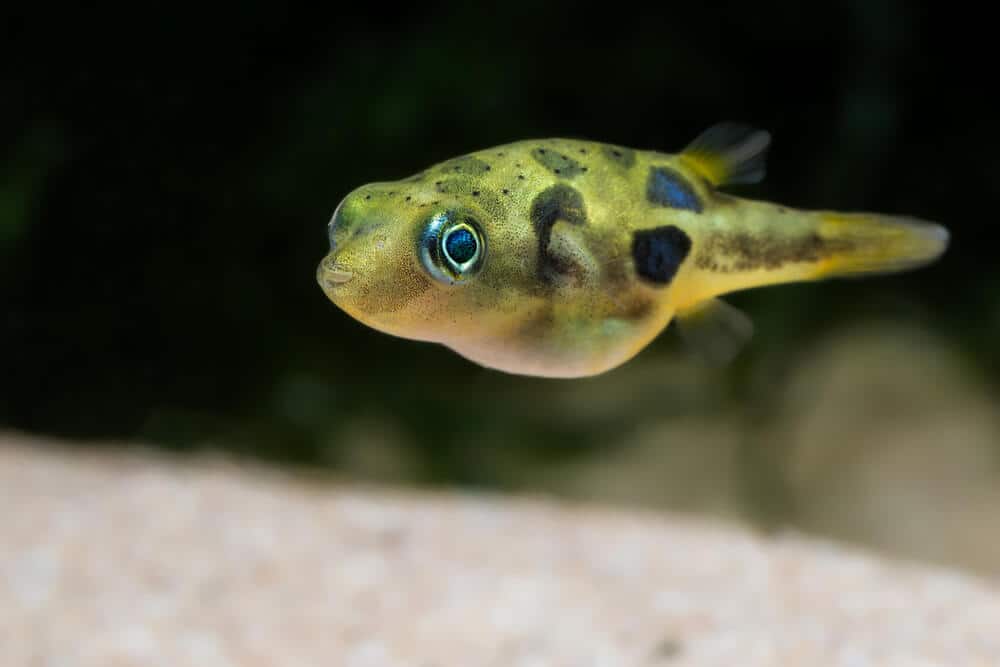Determining the right pea puffer tank mates is a tricky business that requires cautious planning and thoughtful consideration of a few things impacting the health and safety of the fish.
Dwarf pufferfish might be tiny, but they have huge personalities. Although most aquarists keep pea puffers in species-only fish tanks, these fish can also thrive in community tanks.
Beginner dwarf pufferfish keepers must understand their fish’s unique characteristics to make choosing a tank mate more successful. The tank mates should live healthily and safely alongside dwarf pufferfish, creating an ecosystem worth spending hours watching.
Here’s everything you need to know about picking the suitable tank mates for your pea puffers.
What Makes Suitable Pea Puffer Tank Mates?
The ideal pea puffer tank mates should complement the dwarf pufferfish’s characteristics. Suitable fish species will steer clear of the pea puffer’s path or will not put up with dwarf pufferfish bullying.
Hence, peaceful, community fish make the best candidates as dwarf pufferfish tank mates.
Bottom feeders and surface feeders also make excellent tank mates for pea puffers. Dwarf pufferfish prefer swimming in the fish tank’s middle water column. Hence, putting other fish species that dwell either in the upper or lower water column makes perfect sense.
Of course, other factors can come into play when deciding on the fish to share the aquarium with the dwarf pufferfish.
10 Best Pea Puffer Tank Mates
Although we provided an overview of what fish can live with a pea puffer in the same aquarium, we know you are anxious to know what species will be perfect as tank mates.
Here are ten of the best fish species to add to a fish tank with dwarf pufferfish.
1. Kuhli Loach

This omnivorous and bottom-dwelling fish makes a great tank mate for pea puffers. Kuhli Loaches can grow up to five inches long, but their size should not intimidate the tiny dwarf pufferfish because these fish species are peaceful.
They thrive in groups of threes and sixes, making them suitable for a thriving fish community.
Very shy and nocturnal, Kuhli Loaches are secretive and are adept at hiding in aquatic plants.
Although these fishes live at the bottom of the tank, their bodies have defensive spikes to protect them against any attack by pea puffers swimming in the middle water column.
2. Molly

Mollies make excellent tank mates of pea puffers because of their peaceful and easygoing nature. These fish can grow up to twice the size of dwarf pufferfish, a natural defense attribute that protects it against the predatory pea puffer.
Mollies are happiest when kept in harems, ensuring only one male Molly exists in the group.
These fish have sleek bodies, allowing them to swim faster than pea puffers. They also do not have bright coloration, minimizing attraction to the dwarf pufferfish’s curiosity.
Although the tail and dorsal fins fan out, they are not long enough and do not have extensions to make a target for the nippy pea puffer.
3. Leopard/Zebra Danio

Leopard Danios can grow up to 2.5 inches long, while Zebra Danios are about the same size as dwarf pufferfish.
Although Danios are as curious as dwarf pufferfish, they are more peaceful than their puffing tank mates. Feeding them is a breeze, and caring for them is hassle-free.
These fish might be peaceful and docile, but they are tough. Danios also swim relatively fast, allowing them to dodge aggressive maneuvers by other fish species.
They can fend off any attack from pea puffers, making them an excellent choice as dwarf pufferfish tank mates.
4. Cherry Barb

Cherry Barbs make wonderful additions to a tank with dwarf pufferfish, with their shiny reddish-orange bodies adding a pop of vibrancy.
These fish grow a little longer than pea puffers, and they do not have large fins that bait the dwarf pufferfish’s nipping tendencies. Although Cherry Barbs are peaceful, they are courageous enough to fend off any attack.
As a shoaling fish, Cherry Barbs are happiest in groups of six to ten. They are active and social, bringing life and energy into the aquarium.
Their bright coloration should give a nice contrast to a well-planted fish tank and a welcome break from the pea puffer’s drab colors.
5. Neon Tetra

Sporting bright blue and red stripes across their bodies, Neon Tetras make excellent tank mates for pea puffers.
These fish can add color to the aquarium and complement the dwarf pufferfish’s subdued tone. They are peaceful and prefer shoaling to living alone or in small groups.
Neon Tetras thrive well in well-planted aquariums, making them one of the most suitable pea puffer mates. They are half an inch bigger than pea puffers, giving them a natural defense against their more aggressive tank mates.
It would be best to turn the aquarium lighting low to improve Neon Tetras’ sense of security and willingness to swim in more open sections.
6. Platy

Seasoned aquarists consider Platies one of the best fish species for fish communities in freshwater aquariums. Growing about half an inch longer than the dwarf pufferfish, these colorful fish species, with their bright orange bodies and black tails, are never a threat to pea puffers.
These fish have a laid-back personality, making them easy targets for the bullying dwarf pufferfish.
Although these fish do not have defensive features, they do not have long fins or fin extensions that can catch a pea puffer’s attention. Platies do not lay eggs, giving birth to fry instead.
7. Clown Killifish

The Clown Killifish’s bright orange body with red dots and red-lined fins makes a colorful tank mate for the dull-looking pea puffer.
Besides their gorgeous colors, Clown Killifish also have a non-aggressive nature, despite being predatory carnivores. These fish can defend themselves if necessary.
It would be best to pick a pair of Clown Killifish or a harem if you decide to add this species into the aquarium to live with dwarf pufferfish.
Male Clown Killifish tend to be aggressive toward each other and other similar-looking fish species.
8. Otocinclus

It is easy to dismiss the Otocinclus catfish as a boring fish species to add to an aquarium with dwarf pufferfish. However, its social and peaceful nature makes the Otocinclus a perfect tank mate for pea puffers.
These herbivores are larger than dwarf pufferfish, a natural deterrent to bullying and other aggressive tendencies.
The best part about adding 10 to 20 Otocinclus to the fish tank is these fish will keep the aquarium clean. Otocinclus have a knack for eating soft and green algae, maintaining the fish tank’s integrity and the water’s algae-free state.
9. Chili Rasbora

Smaller than the dwarf pufferfish, Chili Rasboras only grow up to an inch long. These fish species love shoaling, requiring a minimum of six Chili Rasboras to guarantee optimum health and even temperament.
Although they are carnivores, Chili Rasboras tend to be uncomfortable and shy in small groups.
Chili Rasboras are perfect for beginner dwarf pufferfish keepers who intend to put the fishes in a small five-gallon aquarium with a single pea puffer.
It would be best to add these fish into the aquarium fully grown because their juvenile size can make them easy prey for voracious dwarf pufferfish.
10. Ember Tetra

Similar to Chili Rasboras in size and behavior, Ember Tetras make excellent tank mates for pea puffers. These fish are omnivores and require only minimum care.
Beginner fish keepers should not have any issues caring for these fish together with dwarf pufferfish.
However, it would be best to introduce only adult Ember Tetras into the aquarium to avoid turning fry and juveniles into instant food for pea puffers.
These fish thrive best in groups of six or more, allowing them to be active and happy while adding color to the fish tank.
The succeeding sections will give you more ideas on how to choose a fish to add to the aquarium and live with pea puffers.
Understanding The Dwarf Pufferfish
Choosing a tank mate for a dwarf pufferfish starts with an understanding of the species.
Knowing its personality, behavior, care requirements, feeding, water parameter requirements, and other characteristics are crucial to shortlisting fish species that can live with the pea puffer in a fish tank.
Size
They do not call these species ‘dwarf’ pufferfish for nothing. With a maximum length of 1.5 inches, pea puffers are some of the smallest fish species one can put in an aquarium.
It is tempting to put a pea puffer in a nano aquarium. However, it is not a good idea because these fish require plenty of space to reduce aggression and feel more secure.
A spacious fish tank also gives tank mates more room to steer clear of the dwarf puffer fish’s way.
It would be best to choose a similarly-sized or slightly larger tank mate, given that the pea puffer is tiny. Adding a larger fish in the aquarium with the pea puffer puts the dwarf pufferfish at risk of being eaten.
Smaller fish also do not have a place in the tank because the pea puffer’s aggressive nature can turn the tiny fish into prey.
Temperament And Behavior
Pea puffers will not attack other fish species dwelling in different aquarium sections.
These fish species prefer staying in the fish tank’s middle water column to scout for food. Hence, it would be best to pick a tank mate swimming in either the top third of the water column or near the bottom.
Unfortunately, dwarf pufferfish are also bullies. It does not matter if the other species is larger than the pea puffer because it will not hesitate to assert its territorial claims.
It would be best not to add another aggressive fish species into the fish tank with a dwarf pufferfish.
Beginner fish keepers must understand that pea puffers are proficient fin nippers.
They will attack long-finned fish, regardless of size. It is always an excellent idea to pick short-finned fish species as their tank mates.
Dwarf pufferfish is also famous for pestering slow-swimming fish. Experts recommend a fast-swimming tank mate, allowing the fish to escape if the pea puffer decides to attack.
After all, pea puffers are like other pufferfish – slow swimmers.
The pea puffer’s territoriality and aggression make it ideal in a single-fish aquarium. These fishes can also live peacefully with other dwarf pufferfish, provided only one male pea puffer exists in the group.
Dwarf pufferfish have a curious nature and are very active. People will see these fishes swimming along the fish tank’s middle water column, moving from side to side, and checking different aquarium features.
It would be best to place fish tank elements that feed the pea puffer’s curiosity to make it happy.
Diet And Feeding

Although pea puffers are tiny, they have a huge appetite. Unfortunately, this fish species does not like commercially-prepared fish food, such as pellets and flakes.
Wild dwarf pufferfish thrive on mosquito larvae, small insects, algae, and tinier fish species.
These fish species eat almost anything alive and moving, making them miniature predators.
Dwarf pufferfish keepers must give their fishes fresh and live bloodworms and other small, protein-rich foods as much as possible.
You can also feed these fish species frozen or live brine shrimp, mosquito larvae, and tubifex.
Diet is a crucial consideration for choosing the suitable fish species to live with the pea puffer in the same aquarium. Hence, it would be best to put the dwarf pufferfish in a fish community with similar dietary requirements.
It is easy to overfeed pea puffers because of their voracious appetite. Unfortunately, overfeeding the fish can lead to health problems. That is why seasoned dwarf pufferfish keepers recommend feeding the fish only twice daily.
Unconsumed fish food can also impact water quality, requiring more frequent water changes.
Failure to clean the tank can promote a rise in nitrate levels, bringing more harm to the pea puffer.
Essential Considerations For Keeping Pea Puffers With Other Fish
Keeping pea puffers with other fish is no easy feat. Aquarists must understand a dwarf pufferfish’s unique attributes before deciding to set up a thriving ecosystem.
The following are additional considerations for choosing a suitable tank mate for a pea puffer.
Tank Setup

Dwarf pufferfish require a spacious aquarium to satisfy their curious nature and active lifestyle.
A single pea puffer needs at least a ten-gallon fish tank to be happy and minimize aggression. The fish tank size also increases by five gallons for each additional dwarf pufferfish.
Aquatic plants are a must for dwarf pufferfish, giving them plenty of hiding spaces.
Building a fish community around pea puffers also requires rocks and driftwoods for other species to conceal and protect against dwarf pufferfish bullying.
Experts recommend Java moss, hornwort, and floating aquatic plants with dangling roots to keep the fish community safe.
The substrate choice should support aquatic plant growth. Hence, seasoned dwarf pufferfish keepers recommend coarse sand or small gravel.
Water Parameters
Dwarf pufferfish cannot tolerate sudden and significant changes in water conditions. That is why avid aquarists always have a water testing kit to monitor the water temperature, hardness, pH, and other parameters.
Pea puffers thrive best in water temperatures between 74 and 82 degrees Fahrenheit.
Fish keepers also need to maintain pH levels between 6.5 and 8.4 (ideal is 7.0 to 8.0) and water hardness levels between four and ten degrees of general hardness (dGH).
It is equivalent to about 0.224 to 0.56 parts per million (ppm) or 0.013 to 0.0326 grains per gallon (GPG).
The water should have zero nitrates, nitrite, and ammonia. It is also worth remembering that dwarf pufferfish are slow swimmers. It would be best to add a sponge filter with an adjustable current in the fish tank.
It is best to consider these pointers when adding a different fish species into an aquarium with pea puffers.
You will want the best ecosystem for all fish species to thrive and live happily and safely, despite some fish having aggressive tendencies.
Frequently Asked Questions
Do Pea Puffers Need Friends?
No, pea puffers do not need friends or tank mates. Although they lead a solitary life, pea puffers never feel alone or suffer from depression.
Unlike most fish, pea puffers thrive in an ecosystem where they can swim sans other species.
Aquarists say pea puffers are more personable if kept in the fish tank by themselves.
Putting three pea puffers in a five-gallon fish tank is okay, as long as the females outnumber the males.
Experts say the ideal ratio is three female pea puffers to each male.
Although pea puffers can live in a community tank, it would be best to be selective of the fish species as tank mates. Larger fish are a no-no with pea puffers because their diminutive size makes them easy prey for the bigger fish.
Long-finned, slow-moving fish should also not be in the community tank because of the pea puffer’s prolific fin-nipping behavior.
Can A Pea Puffer Live With A Betta?
No, a dwarf pufferfish cannot live in the same fish tank as a Betta. Although both species are aggressive and territorial, they have characteristics that put the other at an advantage.
Pea puffers have a knack for nipping at fins. Unfortunately, the Betta has one of the best-looking long fins in the aquarium world.
It does not take a genius to deduce that putting these two fish in the same tank will result in a Betta with tattered fins.
Moreover, pea puffers are slightly more aggressive than Bettas, while Bettas can grow larger than pea puffers.
They also have different water requirements. Bettas thrive in freshwater with a slightly acidic to neutral pH. On the other hand, pea puffers require a mixture of freshwater and saltwater, with a slightly alkaline pH.
Pea puffers also need more frequent water changes because of their propensity to eliminate more waste. Unfortunately, repeated water changes can stress the Betta.
Lastly, Bettas can subsist on flakes and pellets, while pea puffers require meat, preferably live. Dwarf pufferfish might feed on frozen food on rare occasions.
Do Pea Puffers Puff Up?
Yes, pea puffers also puff up like other pufferfish. However, puffing is a rare phenomenon. The only times you might see the pea puffer puffing up is when it acts defensively.
Like any pufferfish, pea puffers suck water to make themselves look bigger and more intimidating. It is a defense mechanism that discourages potential predators.
In some cases, you might see your pea puffer puffing up to practice its defensive capabilities.
Can Pea Puffers Live With Snails?
No, snails cannot live with pea puffers because these mollusks are one of the pea puffer’s natural food in the wild. It is easy for pea puffers to gobble up Bladder snails and other tiny snails.
You might think that a larger snail species is too big for the pea puffer’s mouth. Unfortunately, the dwarf pufferfish has powerful jaws and razor-sharp teeth that can puncture a Nerite snail’s shell.
Even if the snail survives the attack, recovering from the injuries can be challenging.
Do Pea Puffers Bite?

Yes, pea puffers bite. The dwarf pufferfish is a tiny carnivore with razor-sharp teeth and powerful jaws to chomp down on snails, brine shrimp, mosquito larvae, small insects, and other living and moving food items.
A pea puffer can perceive your finger as food, biting it.
However, some pea puffer keepers say their fish do not bite when they dip their fingers into the water.
They also observed that the pea puffers swam away. The only time people see dwarf pufferfish bite the finger is during finger-feeding.
It is worth noting that the bite is more like a nip, with the fish unintentionally biting the finger. Although pea puffers are aggressive, they are not piranhas that will jump onto the finger to devour it the moment it hits the water.
Conclusion
Suitable pea puffer tank mates have the same size as the dwarf pufferfish. They are fast swimmers and dwell either in the aquarium’s top section or near the bottom.
The ideal tank mate for pea puffers should also be peaceful or non-aggressive, and they must be able to escape the slow-moving pea puffer and hide in aquarium plants.
Creating a fish community with pea puffers is possible. Aquarists only need to observe the correct fish tank and water parameter recommendations.
It is also best to consider the tank mate for a dwarf pufferfish to ensure happy, stress-free, and safe living for all species in the fish tank.





